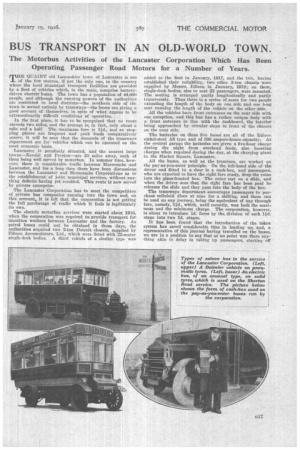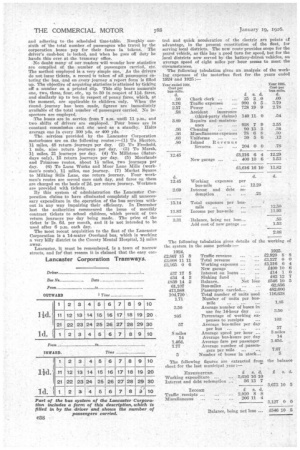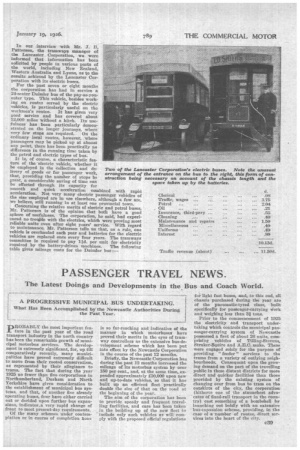BUS TRANSPORT IN AN OLD-WORLD TOWN.
Page 21

Page 22

Page 23

If you've noticed an error in this article please click here to report it so we can fix it.
The Motorbus Activities of the Lancaster Corporation Which Has Been Operating Passenger Road Motors for a Number of Years.
T'
' QUAINT old Laucashire town of Lancaster is one of the few centres, if not the only one, in the country where the local municipal transport facilities are provided by a fleet of vehicles which, in the main, comprise batterydriven electric buses. The town has a population of 44,000 people, and although the running powers of the authorities are restricted to local districts—the southern side of the town is served entirely by tramways—the buses are giving a good account of themselves, in spite of what appear to be extraordinarily difficult conditions of operation.
In the first place, it has to be recognized that no route exceeds two miles, and the average is, in fact, only about a mile and a half. The maximum fare is lid., and as stopping places are frequent and peak loads comparatively scarce, it svill be seen that the demands of the tramways department are for vehicles which can be operated on the most economic basis.
Lancaster is peculiarly situated, and the nearest large towns—Kendal and Preston—are 20 miles away, each of them being well served by motorbus. In summer time, however, there is considerable 'traffic between Morecambe and Lancaster, and for a long time there have been discussions between the Lancaster and Morecambe Corporations as to the establishment of joint municipal services, without anything definite having yet resulted. This route is now served by private enterprise.
The Lancaster Corporation has to meet the competition of private bus companies running into the town and, on this account, it is felt that the corporation is not getting the full percentage of traffic which it feels is legitimately its own.
The electric motorbus services were started about 1916, when the corporation was required to provide transport for munition workers between Lancaster and the factory. As petrol buses could not be obtained in those days, the authorities acquired two 2-ton Detroit chassis, supplied by Edison Accumulators, Ltd., which were fitted with 22-seater single-deck bodies. A third vehicle of a similar type was added to the fleet in January, 1917, and the trio, having established their reliability, two other 2-ton chassis were supplied by Messrs. Edison in January, 1918; on these, single-deck bodies, also to seat 22 passengers, were mounted. The seating is arranged partly longitudinally and partly transversely. Thus there is a series of seats for two people extending the length of the body on one side and one long seat running the length of the vehicle on the other side.
• All the vehicles have front entrances on the near side with one exception, and this bus has a rather unique body with a front entrance in line with the dashboard, the interior being approached by circular steps in front of the chassis on the near side.
The batteries on these five buses are all of the Edison nickel-steel A8 type and of 300 ampere-hours capacity. At the central garage the batteries are given a five-hour charge during the night from overhead feeds, also boosting charges when required during the day, at the charging plant in the Market Square, Lancaster.
All the buses, as well as the tramcars, are worked on the pay-as-you-enter principle. On the left-hand side of the driver and fitted to a door is a cash-box, and passengers, who are expected to have the right fare ready, drop the coins into the glass-fronted box. The coins rest on a slide, and when the driver sees that the right fare has been paid he releases the slide and they pass into the body of the box.
The tramways department encourages passengers to purchase celluloid discs at nine for a shilling, and these can be used on any journey, being the equivalent of any through fare, namely, lid., which, until recently, was both the maximum and the minimum charge. The corporation, however. is about to introduce Id. fares by the division of each stage into two id. stages.
It has been found that the introduction of the token system has saved considerable time in loading up, and, a representative of this journal having travelled on the buses, we are in a position to say that at no point was there anything akin to delay in taking up passengers, starting off
and adhering tothe scheduled time-table. Roughly onesixth of -the total number of passengers who travel by the corporation _buses pay for their fares in tokens. The driver's cash-box is locked, and when he goes off duty he hands this over at tbe tramway office.
No doubt• many of our readers will wonder how statistics are compiled of the number of passengers carried, etc. The method employed is a very simple one As the drivers do not issue tickets, a record is taken of 1:11 passengers entering the bus, and on every journey a report form is filled up. The objective of acquiring statistics is attained by ticking off a number on a printed slip. This slip bears numerals one, two, three, four, etc., up to 30 in respect of lid. fares, and similarly up to ten in respect of penny fares, which, at the moment, are applicable to children only. When the round journey has been made, figures are immediately available of the total number of passengers carried. No inspectors are employed.
The buses are iii. service from 7 a.m. until 11 p.m., and two shifts of drivers are employed. Four buses are in constant commission and one used as a standby. • Halts average one in every 300 yds. or 400 yds. '
The. services provided by the Lancaster Corporation motorbuses are on the following routes :(1). To Skeleton, n miles, 48 return, journeys per day. (2) To Freehold, 1 mile, nine return journeys per day. (3) To Marsh, 11 miles, 21 journeys per day. (4) To Millstone (Saturdays only), 15 return journeys per day. (5) Moorlands and Primrose routes, about 11 miles, two journeys per day. (6) To Lune Works and Moor Lane Mills (workMen's route), 1 miles, one journey. (7) Market Square to Milking Stile Lane, one return journey. Four workmen's routes are served once each day, and fares on them are charged on the basis of 2d. per return journey. Workmen are provided with tickets.
By this system of administration the Lancaster Corporation claims to have eliminated completely all unnecessary expenditure in the operation of the bus services without in any way impairing their efficiency. In December last the authorities commenced the issue of monthly contract tickets to school children, which permit of two return journeys per day being made. The price of the ticket is 2s. 6d. per month, and it is not intended to be used after 6 p.m. each day.
The most recent acquisition to the fleet of the Lancaster Corporation is a 14-seater Overland bus, which is working a very hilly district to the County Mental Hospital, 11 miles away.
Lancaster, it must be remembered, is a town of narrow streets, and foie that reason it is claimed that the easy con trol and quick acceleration of the electric are points cf advantage, in the present constitution of the fleet, for serving local districts. The new route provides scope for the Petrol vehicle, as this has a good turn for speed, but for the local districts now served by the battery-driven -vehicles, an average speed of eight miles per hour seems to meet the 'circumstances.
The following tabulation gives an analysis of the working expenses of the motorbus fleet for the years ended 1924 and 1925
In our interview with Mr. J. E. Patterson, the tramways manager of the Lancaster Corporation, 'we were informed that information has been solicited by people in various parts of the world, including New Zealand, Western Australia and Lyons, as to the results achieved by the Lancaster Corporation with its electric buses.
For the past seven or eight months the corporation has had in service a 24-seater Daimler bus of the pay-as-yououter type. This vehicle, besides working on routes served by the electric vehicles, is particularly useful on the workmen's routes. It has given very good service and has covered about 12,000 miles without a hitch. Its 1.19Cfulness has been particularly demonstrated on the longer journeys, where very few stops are required. On the ordinary local routes, however, where passengers may be picked up at almost any point, there has been practically no difference in the running time taken by the petrol and electric types of bus.
It is of course, a characteristic fea ture of the electric vehicle, whether it be employed in the collection and delivery of goods or for passenger work, that, providing the number of stops be great, a considerable saving of time can be effected through its capacity for smooth and quick acceleration combined with rapid acceleration. Not very many electric passenger vehicles of the size employed are in use elsewhere, although a few are, we believe, still running in at least one provincial town.
Concerning the relative merits of electric and petrol buses, Mr. Patterson is of the opinion that both have a good sphere of usefulness. The corporation, he said, had experienced no tronble with the electrics, which were proving most reliable units even after eight years' service. With regard to maintenance. Mr. Patterson tells us that, as a rule, one vehicle is overhauled each year and batteries for the electric vehicles are replaced once every four years. The tramways committee is required to pay 14d. per unit for electricity
required by the battery-driven machines. The following table gives mileage costs for the Daimler bus:—






























